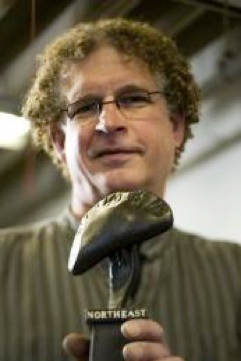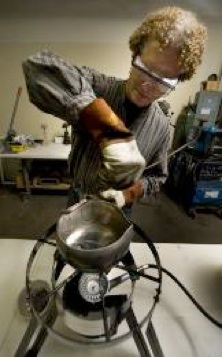


The Pierogi Project
PRESS

Other
Media
On March 23, 2010 Roadside America ran a piece on The Pierogi Project
which you can read by clicking on the following image:


The Minneapolis Star Tribune ran the following article on the front page of its Saturday January 23rd, 2010 edition:
Artist hopes a pierogi will rise in Northeast
Jeff Lohaus has a vision to give the stuffed dumpling a towering tribute in northeast Minneapolis.
By ABBY SIMONS, Star Tribune
Last update: January 23, 2010 - 2:43 PM
Jeff Lohaus Heating pewter
David Brewster, Star Tribune
Artist Jeff Lohaus chewed on a few ideas before settling on a project that would honor both his northeast Minneapolis neighborhood's East European heritage and the diversity of its latest immigrants.
He came up with this: a majestic, 17-foot pedestal of bronze and brick, placed on the corner of Central and Lowry Avenues and topped by ... drumroll, please ... a pierogi.
A pierogi pierced by a fork, lest someone think it's some kind of mollusk up there.
It's still just an idea -- Lohaus has raised only a fraction of the $100,000 needed to create the pierogi -- but he and neighborhood leaders who enthusiastically embraced his vision ask that you bear with them while they explain the rationale behind their towering "Pierogi Project."
The pierogi is a hollow, unleavened dumpling that can be stuffed with cabbage, sauerkraut, meat, cheese, even fruit. It was all the rage in Poland, the Slavic countries and other homelands of the northeast neighborhood's first immigrants.
It remains a popular food among residents of such heritage, including Lohaus, whose maternal grandparents are from Poland.
But how would paying homage to the pierogi honor the neighborhood's newest immigrants, from places such as Mexico and Asia? Lohaus says the answer is simple: Filled and cooked pockets of dough are a nearly universal food. Mexicans call them empanadas. Tibetans call them momo. Nestlé calls them Hot Pockets.
The statue would celebrate this universality with an inscription: "Northeast Culture World Culture," and a list of pierogi-like foods, from the British pasty to the Chinese jiaozi (better known here as the potsticker).
"It's not just about one culture; it's about the whole changing demographic of northeast Minneapolis," said Lohaus, 53, an Omaha native who has lived in Minneapolis 11 years, six in Northeast. "It seems like a piece that will touch a lot of people."
He hopes to raise enough money to have the statue in place by spring or summer.
The project began to germinate in February 2008, when Lohaus won a $1,000 research grant from St. Paul-based nonprofit Forecast PublicArt. After settling on the pierogi idea, constructing models and even traveling to Poland for research, he unveiled the design at the Twin Cities Polish Festival last August.
"The whimsical nature of it really struck me," said Melinda Childs, grant manager for the nonprofit, who lives four blocks from the proposed site. "If I wouldn't have seen the design, it would be harder to imagine. It's definitely funny, but the more you think about it and let it sink in, it is appropriate for Northeast in kind of a strange way."
It also might serve as a symbol of revitalization for a corner that could use some, said John Vaughn, executive director of the Northeast Community Development Corp.
"When the pierogi came along, it was like 'Ahhhh,'" said Vaughn, invoking the sound of a choir of angels singing as clouds part.
Joe Hatch-Surisook, who with his wife owns Sen Yai Sen Lek, a Thai restaurant across the street from the site, said that though he hasn't given the Pierogi Project much thought, he supports it.
"I think it's a good thing, harkening back to what I understand Central Avenue used to be like, in terms of Eastern European culture," he said. "It's nice to recognize how it's changed today."
It may come as a surprise that the towering pierogi wouldn't be the world's first. The village of Glendon, in Alberta, has "The World's Largest Pyrogy," also fork-pierced, in Pyrogy Park.
Abby Simons • 612-673-4921
